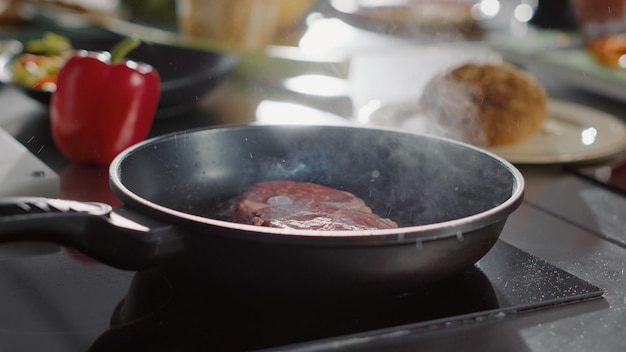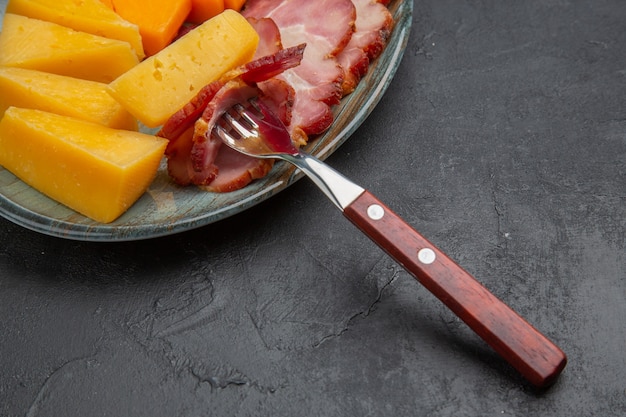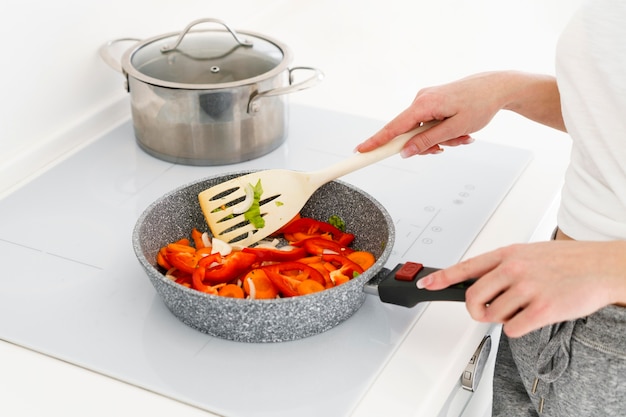Let's face it, folks. There's nothing quite like the satisfying crunch of perfectly cooked bacon. It's a breakfast hero, a lunchtime treat, and the ultimate topping for anything from burgers to salads. But achieving that glorious golden-brown, crispy perfection can feel like a culinary mystery. I've been there, with many a bacon experiment ending in a soggy, disappointing mess. But fear not, dear readers! After years of trial and error, I've cracked the code to pan-cooked bacon nirvana, and I'm ready to share my secrets with you.
In this comprehensive guide, we'll embark on a journey into the art of pan-cooking bacon, from choosing the right cut to mastering the technique. We'll explore the science behind the perfect crisp, address common pitfalls, and even tackle some of your most pressing bacon-related questions. So grab a cuppa, settle in, and prepare to elevate your bacon game to a whole new level. Because trust me, once you've tasted truly crispy bacon, there's no going back.
Part 1: The Bacon Basics

Let's begin with the foundation of a successful bacon journey: choosing the right cut. You see, not all bacon is created equal, and understanding the nuances can make a world of difference in your final result.
bacon varieties: A Breakdown
The world of bacon is a diverse and delicious one, with a variety of cuts and styles to satisfy every palate. Here's a rundown of some popular choices:
- streaky bacon: This is the classic, thin-sliced bacon you'll find in most grocery stores. It's often called "American bacon" and is known for its high fat content, which renders beautifully and results in a crispy, melt-in-your-mouth texture. If you're after that quintessential bacon flavour, streaky bacon is your go-to. It's also incredibly versatile, from breakfast sandwiches to salads.
- back bacon: This thicker, leaner cut is more common in the UK and Ireland. It's made from the loin of the pig, and its robust flavour is a testament to its leaner profile. Back bacon holds its shape well during cooking, making it ideal for grilling or frying. It's also a wonderful addition to a hearty breakfast or a traditional full English.
- smoked bacon: Most bacon is smoked, but there are varying levels of smoke intensity. If you prefer a milder taste, look for a lightly smoked bacon, where the smoky flavour is subtle and nuanced. For those who love a smoky punch, embrace the bolder flavour of a more heavily smoked option. It adds a delicious depth of flavour to any dish.
- Dry-Cured Bacon: This is the ultimate in flavour and texture. Dry-cured bacon undergoes a longer curing process, resulting in a richer, more complex taste and a delightfully firm texture. It's often more expensive, but worth the splurge for a special occasion or when you want to elevate your bacon game to a new level.
For this guide, we'll be focusing on streaky bacon, as it’s the most versatile and commonly available type for pan-cooking. However, the principles we discuss can be adapted for other varieties as well. Experiment and discover what your taste buds crave!
The Key to Crispy Bacon: Fat Content
Now, let's talk about the secret ingredient to crispy bacon: fat! The higher the fat content, the crispier your bacon will be. It’s that simple. When you cook bacon, the fat renders out, creating a pool of flavourful oil that helps to brown and crisp up the bacon itself. That golden-brown colour and satisfying crunch you crave? It's all thanks to the fat. So don't shy away from fat! It's your bacon's best friend.
Part 2: The Perfect Pan: Finding Your Culinary Match

Now that we’ve chosen our bacon, we need to find the perfect pan. This isn't just any old kitchen utensil. It’s an essential tool in our quest for crispy bacon glory. Think of it as a culinary partner, working alongside you to achieve bacon perfection.
The Cast Iron Classic
For me, there's no better pan than a seasoned cast iron skillet. This workhorse of the kitchen is built for high heat and even cooking, which are critical for achieving crispy bacon. Its heavy weight helps to distribute heat evenly, ensuring consistent browning across every slice. It's like a culinary hug, cradling the bacon and ensuring it cooks evenly. Plus, there's something wonderfully satisfying about cooking with cast iron, knowing it's a piece of kitchen history.
Here's what I love about cast iron:
- Even Heat Distribution: cast iron skillets retain heat remarkably well, ensuring that your bacon cooks evenly without burning. It's a true heat-hugging champion, keeping the bacon warm and happy while it cooks.
- Natural Seasoning: With proper care, cast iron develops a non-stick patina, making it easier to cook and clean. It's like a culinary handshake, built up over time, making cooking a breeze.
- Long-Lasting: These skillets are built to last generations, making them a worthy investment. They truly are a legacy in the kitchen, passed down from generation to generation, sharing the love of good cooking.
Beyond Cast Iron: Other Options
Cast iron isn't the only game in town! Here are some other pan choices that can work well for cooking bacon:
- Stainless Steel: Stainless steel skillets are a good choice for everyday use. They're relatively affordable and easy to clean, but require more careful temperature control. You'll need to keep a close eye on the heat, making sure it doesn't get too high, or your bacon might end up burnt.
- Non-Stick: While these pans are great for eggs and pancakes, they're not ideal for bacon. The high heat needed for crisping can damage the non-stick coating over time. I've learned that the hard way. Trust me, a good cast iron is worth its weight in gold when it comes to bacon.
No matter what pan you choose, make sure it’s heavy-bottomed and wide enough to allow the bacon to cook evenly without overcrowding. Remember, we want the bacon to sizzle, not steam. A crowded pan will lead to soggy bacon, and no one wants that.
Part 3: Temperature: The Golden Rule

Now, for the crucial part: temperature! Get this wrong, and you’ll end up with soggy bacon. Trust me, I’ve been there. The key is to find the sweet spot—hot enough for crisping, but not so hot that it burns. It’s a delicate dance, but with a little practice, you'll become a maestro of bacon temperature.
Medium-High Heat: The Ideal Zone
I’ve found that medium-high heat is the golden rule for pan-cooking bacon. It's the perfect balance between rendering the fat and achieving a crispy finish. My advice? Don’t be afraid to crank up the heat. Just keep a watchful eye, and adjust as needed. And listen to the sizzle—it's a delicious indicator of the cooking process.
Testing the Heat: The Water Test
An easy way to check if your pan is hot enough is to use the “water test”. Add a few drops of water to the pan. If they sizzle and evaporate instantly, the pan is hot enough for bacon. If the water sits for a few seconds or just gently bubbles, it’s not hot enough. Remember, the heat needs to be intense! The bacon should sizzle as soon as it hits the pan.
Part 4: Cooking Technique: The Art of the Sizzle
With our chosen pan sizzling away, it’s time to unleash the bacon. This is where our skills come into play. We’re not just cooking bacon, we’re orchestrating a symphony of sizzle and crunch. It’s a culinary performance, and you’re the conductor.
Single Layer Cooking: The Key to Crispness
To achieve even cooking and optimal crispiness, it's crucial to avoid overcrowding the pan. Cook the bacon in a single layer, allowing the fat to render properly and the surface to brown evenly. Don’t try to cram in too much, as this will only lead to soggy bacon. We want that golden perfection! Imagine each slice of bacon basking in its own pool of rendered fat, reaching its full crispy potential.
The Flip: Timing is Everything
Once the bacon starts to release its fat and turn a light golden colour, flip it over. This is where patience comes into play. No need to rush! You want to ensure the bacon is cooked evenly on both sides. And keep an eye on that sizzling oil—it’s a visual indicator of the cooking process. You'll notice a change in the sound of the sizzle as the fat renders and the bacon starts to crisp up.
The Finishing Touch: The Flip-Flop
As the bacon approaches your desired level of crispiness, you can try a little trick I like to call the “flip-flop”. Simply flip the bacon back to its original side for the final few minutes of cooking. This helps to ensure that both sides get a nice, even browning. It’s the final flourish, a touch of culinary finesse, taking your bacon from good to great.
Part 5: Don’t Be Afraid to Get Messy
As your bacon sizzles away, you might find yourself with a pan full of delicious, golden-brown bacon fat. Don’t be tempted to pour it down the drain! This golden liquid is a culinary treasure, waiting to be put to good use. It's a testament to the flavour of the bacon, a gift from the cooking process.
Bacon Fat: The Flavour Elixir
Bacon fat is a flavour enhancer like no other. It’s incredibly versatile and can be used in a variety of dishes. Here are a few ideas to inspire your culinary creativity:
- Pan-Frying: Use bacon fat to fry eggs, potatoes, or even vegetables. The subtle smoky flavour will elevate your dish to a whole new level. The richness of the bacon fat will enhance the taste of your eggs and add a lovely, crispy texture to your potatoes.
- Sautéing: Bacon fat adds a depth of flavour to sautéed mushrooms, onions, and garlic. It’s the perfect way to add a smoky touch to your next pasta dish. The fat will caramelize the onions and mushrooms, creating a flavourful base for your pasta sauce.
- Baking: Use bacon fat to create deliciously crispy cookies or add a unique flavour to your next batch of cornbread. It’s a culinary secret weapon! The fat will create a beautifully golden crust on your cookies, adding a touch of savoury goodness. And for cornbread, it will enhance the flavour and texture, adding a richness that you won't find anywhere else.
To store bacon fat, simply strain it through a fine-mesh sieve lined with cheesecloth or a paper towel to remove any bits of bacon. Then, store it in an airtight container in the refrigerator. It will last for several weeks. I always keep a jar in my fridge, ready for my next culinary adventure. Because why waste such a precious resource?
Part 6: The Perfect Crisp: Signs of Success
With a watchful eye and a sizzle in the air, you’ll know when your bacon is reaching peak crispiness. Look for these tell-tale signs of success: Each one is a delicious indicator that your bacon is nearing perfection.
- Golden Brown Colour: The bacon should be a rich, golden brown, not pale or white. We’re aiming for that irresistible, browned hue. It's a sign that the fat has rendered properly, creating that beautiful golden colour and crispy texture.
- Crispy Edges: The edges of the bacon should be crisp and slightly curled. This is the hallmark of perfectly rendered fat. The fat has melted away, leaving behind a firm, crispy edge that will snap when you bite into it.
- Firm Texture: When you gently press on the bacon, it should feel firm and springy, not floppy or greasy. It should have a satisfying crunch when you bite into it. This is a sign of a well-cooked bacon, with the fat fully rendered and the texture transformed.
- Sizzling Sound: The bacon should be sizzling happily in the pan. If the sizzling slows down, it's a good indication that it’s getting close to being done. Listen to the symphony of sizzle! It's music to your ears, a sound that tells you bacon perfection is just around the corner.
Once you reach this point, you’ve achieved bacon perfection. It’s a moment of culinary triumph! Take a moment to admire your work, the delicious reward for your patience and culinary skills.
Part 7: The Art of Bacon Removal: A Gentle Touch
It’s time to remove your bacon masterpiece from the pan. This is a delicate operation, so handle with care. We want to preserve that hard-earned crispiness. No one wants soggy bacon, especially when you've put so much effort into achieving perfection.
The Tongs: Your Culinary Allies
I recommend using tongs to remove your bacon. They provide a firm grip without crushing the delicate slices. Use the tongs to carefully lift the bacon out of the pan and place it on a wire rack. This allows the bacon to drain any excess fat and prevents it from becoming soggy. The wire rack will act as a support, allowing the bacon to breathe and cool, ensuring it stays crisp and delightful.
The Paper Towel Method: The Final Touch
To further enhance the crispiness, you can transfer the bacon to a paper towel-lined plate. This will absorb any remaining fat, ensuring a satisfyingly crunchy bite. And remember, that golden bacon fat is a treasure, not trash. Store it in a jar for later use!
Part 8: FAQs: Your Bacon Conundrums Solved
Now, let's tackle some of the common bacon-related questions that may be swirling in your mind. Because let's be honest, there's always something we want to know about bacon.
FAQs
| Question | Answer |
|---|---|
| How do I make extra crispy bacon? | To achieve extra-crispy bacon, you can cook it for a longer period of time at a slightly higher temperature. Just keep a close eye on it to prevent burning. You can also place the bacon on a baking sheet in a preheated oven at 200°C (400°F) for a few minutes after pan-cooking to further enhance the crispiness. This will give you that extra-crunchy bite you crave. |
| Can I cook bacon in the oven? | Yes, you can cook bacon in the oven. Preheat your oven to 190°C (375°F). Arrange the bacon in a single layer on a baking sheet lined with foil or parchment paper. Bake for 15-20 minutes, flipping halfway through. This is a great option if you want to cook a larger batch of bacon, as it frees up your stovetop for other culinary creations. |
| What do I do if the bacon is too salty? | If your bacon is too salty, you can try soaking it in cold water for a few minutes before cooking. This will help to remove some of the salt. You can also add a splash of water to the pan while cooking, which will help to dilute the saltiness. Just be careful not to add too much water, or you'll end up with soggy bacon. |
| Can I reheat bacon? | Yes, you can reheat bacon. The best way to reheat bacon is in a preheated oven at 120°C (250°F) for a few minutes. You can also reheat bacon in a skillet over low heat, but be careful not to burn it. Reheating bacon in the oven is a great way to preserve its crispiness, while a skillet over low heat is a quick and easy option for smaller quantities. |
| What can I do with leftover bacon? | Leftover bacon is a culinary treasure! You can add it to salads, sandwiches, pizzas, or pasta dishes. You can also chop it up and use it as a topping for soups or baked potatoes. Get creative, my friends! The possibilities are endless with leftover bacon. |
I hope this guide has equipped you with the knowledge and confidence to conquer the art of pan-cooking bacon. Remember, it’s all about patience, attention to detail, and a dash of culinary flair. So go forth and sizzle your way to bacon perfection! And don't forget to share your crispy bacon creations with the world. Because good bacon deserves to be shared.
Everyone is watching

How to Cook Frozen Lobster Tails Perfectly: A Step-by-Step Guide
RecipesLobster. Just the word conjures up images of lavish meals, special occasions, and a taste of luxury. But let's...

Pork Fillet Cooking Time: How Long to Cook It Perfectly
RecipesPork fillet, or tenderloin as it's sometimes called, is a real favourite in our house. It's so versatile, and...

Pigs in a Blanket Cooking Time: How Long to Bake for Perfect Results
RecipesAh, pigs in a blanket. Just the name conjures up images of those delightful little parcels of crispy pastry en...

The Ultimate Guide to Cooking Delicious Frankfurters
RecipesLet's face it, we all love a good frankfurter. It's a classic, simple, and always satisfying. But let's be rea...

Wolf Meat Recipes: A Guide to Cooking Wild Game
RecipesLet's be honest, you don't see wolf meat at your local butcher shop every day. It's a bit of a wild card, but ...
